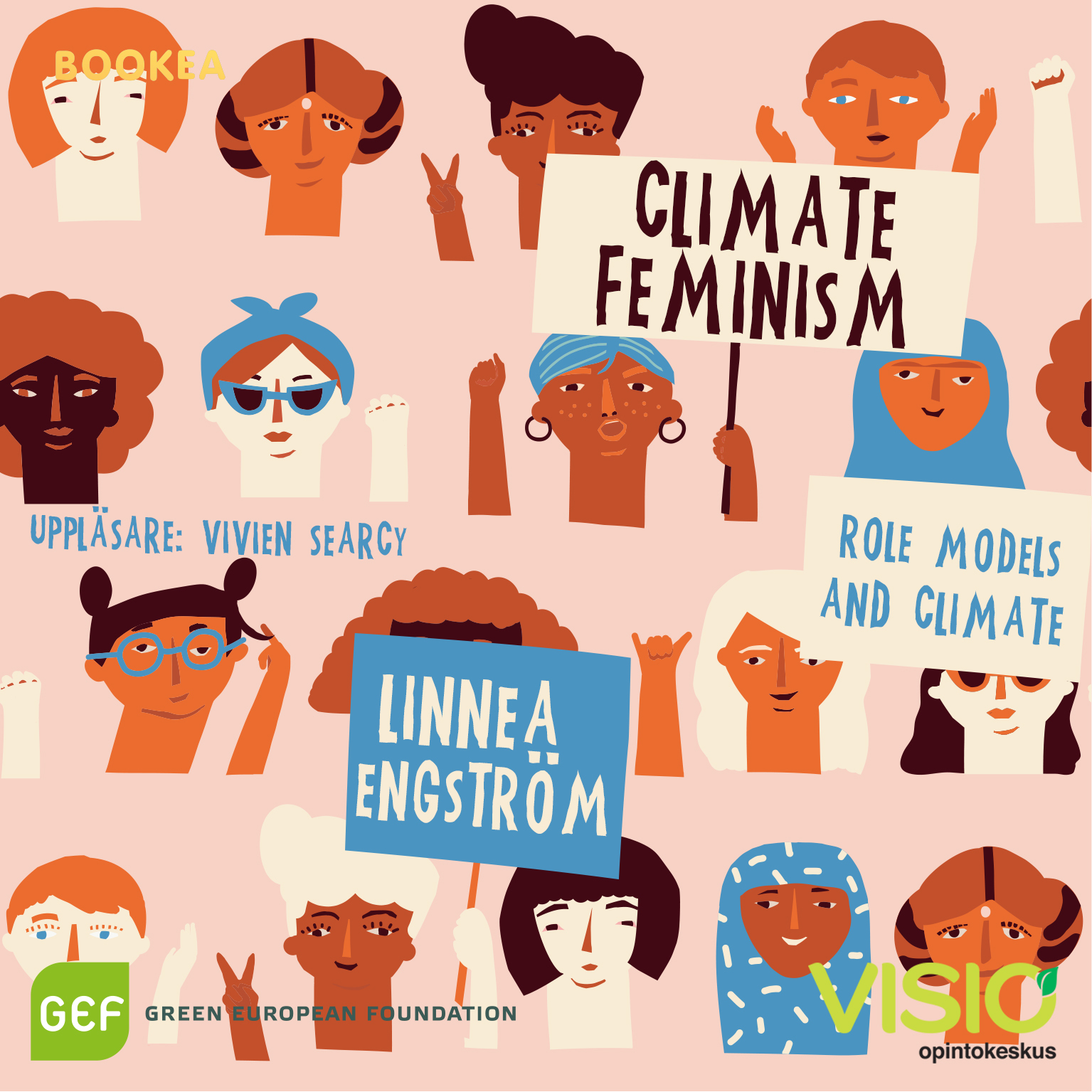
Overview
Do you sometimes feel lost in discourses around intersectionality, waves of feminism, and anti-gender backlash? Do you want to explore what feminism entails in the present day, from social media to activism and politics? Or do you perhaps want to better understand the interconnections between feminist and green thinking?
This introduction consists of texts, reflection exercises and videos on seven different themes relating to green feminism, through which you’ll acquire a great overview on the current discourses on at the intersection of feminist and environmental thinking – including a number of examples on political measures that have the potential to transform our societies into thriving environments of equal opportunities for a diversity of life paths.
After reading this introduction to Green Feminism,
- you will better understand the basic premises and objectives of feminism
- you will be able to connect feminist theories and movements to green ideology, and understand how feminism is central to green politics
- you will be able to apply feminist perspectives in diverse situations and reflect your own position in relation to other people and society
- you will be able to identify connections of feminism to different areas of politics and human and non-human life
- you will better understand some key feminist struggles and challenges at European and national level, and why we must stay vigilant amid forces of backlash
Throughout this text, you will find reflection sections highlighted with a green bar. They are there to help you engage with the text and think about how the things you learned translate into your everyday life. You can reflect on the questions by writing down your answers in a notebook, or by engaging in a conversation with your peers
1. What is Green Feminism?
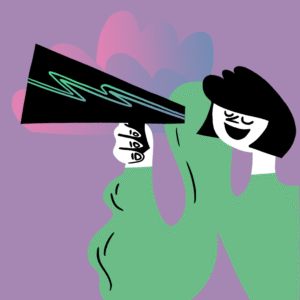
1.1 Orientation
Learning objectives for the introduction chapter:
- You are informed about the general development, basic premises and objectives of feminism, including:
- Gender roles
- Intersecting oppressions and privileges
- Waves of feminism
- You know what the fundamental connection of the green movement to feminism is.
1.2 What is Feminism?
“Feminism is the radical notion that women are people.” This quote is one of the definitions of feminism. It was a very apt definition at the time, and it is not completely outdated even today.
In addition to improving the position of women, feminism in the 2020s is characterised by a focus on intersectionality, i.e. acknowledging that people may be discriminated against for many different reasons. Those who face discrimination for multiple intersecting reasons are often at the greatest disadvantage. Today’s feminism also recognises that discrimination and oppression due to gender or other factors are not limited to women. For this reason, feminism advocates and should advocate not only for women but also for minorities and other disadvantaged groups. The present gender system hurts everyone. Some examples include women’s earnings being lower, men being more likely to end up homeless, the responsibilities and joys of parenting being distributed unevenly, only men being subject to military conscription, and women’s health issues, even serious ones such as heart attacks, being more likely to remain undetected and untreated even if women seek medical care. Not to mention that our system based on two genders causes all kinds of problems for people who do not identify as men or women or who are misgendered.
Feminism provides us with the tools and concepts we need to break down the gender system and replace it with a world founded on self-identification, individual decisions, and kinder role expectations. Feminism strives for a better world where all people can be met as themselves and seen as they are. In a feminist world, we are not primarily seen as representing a certain gender, sexual orientation or skin colour, but as human beings. In a feminist world, our language, society, health and social services, schools, and judicial system conform to the people they come into contact with – not the other way around. For now, such a world is still far away.
Above all, feminism is a way of viewing the surrounding world and its structures, seeking to unlearn harmful ways of thinking, and applying these norms to both oneself and others. It is an aspiration to meet the other person as an individual, and a willingness to alter the prevailing structures so that we are all free to choose how we want to live our own lives, with no structural constraints.
Even today, there are many contexts in both language and reality where ‘people’ refers to nondisabled, middle-aged white men, and everyone else is an exception. Despite active efforts to resolve this issue, we still find ourselves in a situation where the world is designed on men’s terms. There are countless examples of this. The male as norm principle affects both large matters of life and death and small everyday issues. Cars and their safety devices are designed for the dimensions of the average man, which results in women being more likely to die in car crashes relative to the number of accidents. The main characters in children’s cartoons are most often men and boys, while girls are relegated to side characters, drawn with massive eyelashes and bowties on their head, and given very little agency. In many languages, the word ‘man’ is synonymous with human being.
At the same time, men are forced into a much narrower gender role than women. In most parts of the world, women and girls have been allowed to wear trousers for a long time, but many people still regard men in skirts as a funny joke, and there are still comedy shows on television that keep relying on this tired old gag.
For some reason, most languages have plenty of professional titles referring to men that can be applied broadly to professionals of any gender (e.g. fireman, chairman, palomies, kirvesmies, lakimies, puhemies, asiamies, Feuermann, brandman, timmerman, talman, ombudsman). However, when men enter a field where the established title refers to women, a gender-neutral title is quickly adopted for either men or all professionals in this field. For example, hôtesse de l’air (air hostess) changed to steward and sage-femme (midwife) to maïeuticien/sage-homme when referring to men, and nurses became Krankenpfleger instead of Krankenschwester.
1.3 Waves of Feminism
5.WavesofFeminism
1.4 Feminism and the Green Movement
In the case of most western European Green parties, women’s rights and female empowerment has run along the values and agendas of their politics from the founding days. It has been one of the factors setting the green political movement apart from the traditional parties. This also stems from the fact that Green politics has always been rooted in grassroots activism, including women’s rights movements as well as environmental, peace and human rights movements.
At the core of Green thinking lies the need to spotlight those fighting for a better future, and to widen the collective knowledge that determines policymaking to reflect the diversity of humanity. The green political movement is a fruitful growing bed for transformation of political and societal structures, which is the overarching objective of feminist movements too.
Gender equality does not remain only talk within the green political movements. The Greens have taken concrete measures within their own structures as well as initiated campaigns and policies within wider society to take steps towards gender equality and more diverse political representation. As a result, the Greens are the most gender-balanced group in the European Parliament, in fact the only one with a majority of women (2020); and the European Green Party has a policy of minimum 50% female representation in EGP and its constituent working groups and networks. Many Green parties and political structures across Europe are also pioneers of co-leadership models. These structurally ensure non-male representation in the highest levels of power, while also encouraging more sustainable, accessible, and balanced forms of leadership for all, as co-leaders are able to rely on each other when juggling other aspects such as family life, community responsibilities, and health.
Take a moment to think about how you’ve come to understand the word “feminism.” Where did those ideas come from: family, media, school, or activism? Can anyone claim feminism, or does it require certain values or actions to be a feminist?
Now think beyond theory:
- If a close friend described themselves as a feminist, what would you expect that to mean in how they live their life?
- Think of a time when you saw feminism in action in your everyday life, or perhaps the lack of it. What did that look like?
- Where do you see green values and feminist values intersecting in your daily decisions, like how you consume, vote, or care for others?
2. Power
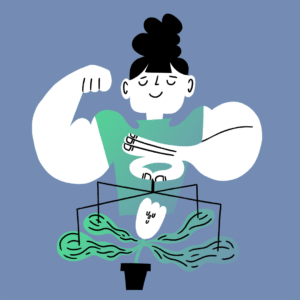
2.1 Orientation
Learning objectives for this chapter:
- You will know what the current situation with gender balance in European decision making is
- You can describe some of the paths towards gender-sensitive decision making
Reflect on the questions below to start thinking about the theme of power.
Think about the two words feminism and power:
- What connotation does this brings to your mind?
- What is your own feeling about this topic?
- How might your feelings and expectations about the topic affect your learning?
Do you see yourself in possession of power? Why / why not?
2.2 Feminism and Power
Few people say they want power, but in practice, even fewer turn it down. Power is the chance to make a difference in how matters progress. Of course, there are many different types of power, but in essence, power creates opportunity. It is a tool for creating change and making one’s voice heard. In many elections, women’s rights organisations have campaigned to get women to vote for women. This can be a good start, as we know that men almost exclusively vote for men and women often vote for them, too. In Finland, this setup has gradually broken down, but still the first and so far only elections held in Finland where more women were elected than men were the 2022 county elections. Such examples are also quite rare elsewhere in the world. At the time of writing, the only country with a female-dominated unicameral parliament is Cuba. Out of all countries with a bicameral parliament, women only hold the lower-house majority in Rwanda and Bolivia, and there are no upper houses with a female majority.
In addition to fixing the gender imbalance in decision-making, we need to introduce gender sensitivity, gender impact assessments, and a radical ability to question the established way of doing things into the decision-making process. The old ways and structures cannot be eliminated by simply adjusting the gender division of decision-makers. It is also necessary to make gender-sensitive decisions and put the patriarchy that oppresses everyone firmly in the past. To support this development, we need structures. These structures – gender quotas, legally required gender impact assessments, a family leave system that encourages more equal arrangements, and so on – help us pave the way towards a more equal society.
Gender equality is not truly achieved if the term is only added to decisions as an afterthought, let alone if it is falsely assumed that equality has already been achieved and efforts to advance it are no longer necessary. Thus, we must strive to make sure that the gender impact of each decision and the cultural and legislative structures that enforce that impact are understood by officials on all levels. If these matters are not understood, the decisions fall short. Good intent alone is not enough. Advancing equality also takes expertise, comprehension, and skill.
In addition to these, there must be a willingness to predict the impact of each decision on different genders. Making decisions is significantly more straightforward if their gender impact is not taken into account; even just the fact that there are fewer factors to consider makes the work easier. However, the decision-making process is incomplete if the gender impact is not assessed. This also makes the justification for the decisions less robust and the true outcomes harder to predict. Neglecting the gender impact of decisions is particularly lazy in social policy, as its fundamental purpose is to guide people’s actions.
2.3 Susi Nousiainen on acknowledging one’s position
Practicing intersectional feminist understanding – also in decision-making – begins from acknowledgement of one’s own position in relation to other people. Watch the lecture given by project researcher Susi Nousiainen to understand how everyone benefits from acknowledging their own position in the society – privileges and oppressions they possess and are exposed to – and how their position empowers them to act in different ways towards a better future. After watching this video you will understand the basic constitution of power held by an individual and how to use it for good.
2.4 Parity in European Politics
The Greens in the European Parliament are the most gender-balanced political group and notably the only one with a female majority. Their commitment to gender equality is not only reflected in policy positions but also embedded within their internal structure. All organs of the European Green Party (EGP), including each national delegation, are required to consist of at least 50% women. This gender balance is also a condition for accessing participation funding, which incentivises compliance. As of May 2022, Estonia and Moldova stand out as the only two European countries with both a female head of state and a female head of government:
- Estonia: Kaja Kallas (Prime Minister) and Kersti Kaljulaid (President)
- Moldova: Natalia Gavrilita (Prime Minister) and Maia Sandu (President)
More broadly, 13 out of 45 European countries had a woman serving either as president or prime minister. These countries included:
- Estonia, Denmark, Finland, France, Greece, Hungary, Iceland, Kosovo, Lithuania, Moldova, Serbia, Slovakia, and Sweden.
Conversely, Bulgaria was the only EU country where the proportion of women in parliament declined between 2003 and 2021, dropping from 25.9% to 24.6%. On the more progressive end, France and Italy have made significant advances in female parliamentary representation: In France, the proportion of women in parliament rose from 12% in 2003 to 39% in 2021. In Italy, this number grew from 10% to nearly 36% over the same period.
A study by the European Institute for Gender Equality (EIGE) found that the adoption of gender parity laws accelerates progress significantly, tripling the pace at which women’s representation increases. As of now, 11 EU member states have implemented legal quotas for female representation in parliamentary elections: France: 50% (2000), Belgium: 50% (2002), Portugal: 33% (2006), increased to 40% (2019), Slovenia: 35% (2006), Spain: 40% (2007), Greece: 33% (2008), increased to 40% (2019), Hungary: 40% (2008), Poland: 35% (2011), Ireland: 30% (2012), Luxembourg: 40% (2016), Italy: 40% (2017)
3.Money
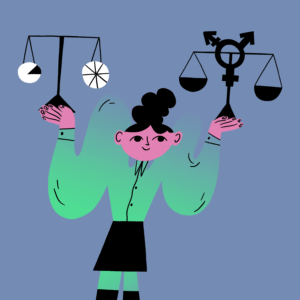
3.1 Orientation
Learning objectives of this theme:
- You will be able to identify the gendered elements in the economy and economics.
- You are familiar with some mechanisms of economic policy that can constitute the steps towards a more equal future.
- You know some recent Green examples to fight the gender imbalance in economics and economic policy.
Reflect on the questions below to orientate to the upcoming theme of money.
Think about your personal relationship with money:
- Do you value financial security or wealth, or is money low in your list of priorities?
- How might your relationship with money affect your position as an influencer?
What comes to your mind when you think of injustice in relation to monetary resources and the economy?
3.2 Money and the Economy
Money is something most of us cannot avoid being at least somewhat interested in. Rosa Meriläinen, an active participant in public debate and former Green Member of Finnish Parliament, has said that only the rich can be completely indifferent to money. This is absolutely true. The rest of us have to take an interest in how we can afford to buy food, pay our rent or mortgage, and cover our other essential expenses.
The same thing applies to decision-making on all levels. Money sets the framework for what is possible, which means that people with a better grasp of money may easily impose their views on those who are less knowledgeable or indifferent to it. Each and every person who is interested in changing the world should also be interested in money. Understanding the economy makes it easier to participate in decision-making with independent arguments guided by one’s own values, instead of being led by others. This principle applies to both social participation and the personal economy.
In social discourse, it is particularly typical for economy-oriented debaters to suggest that their arguments are rational while those made by debaters with different values are emotional. Of course, everyone should stick to the facts, but the people talking about the economy rarely have a broader comprehension of those than anyone else. Decision-making usually boils down to value-based choices in relation to the resources. In other words, choosing the causes to advance with the limited resources and thereby taking the society in a specific direction.
So, here is a tip for us all: be on your guard when someone claims their argument is rational and everyone else’s arguments are emotional. It is highly likely that this is untrue, and your argument is just as rational as theirs. The positions should therefore be debated to find either the most broadly supported option or the best compromise.
It is very common to hear claims about all kinds of threats to the public economy. The sustainability gap and public debt are examples of typically cited risk factors. The decision-makers have many different fiscal measures at their disposal, from spending cuts and higher service fees to various kinds of tax increases. For example, raising taxes may have some unwanted effects, but it can also be a way of steering people’s behaviour in the desired direction. In any case, both tax increases and tax cuts are part of the toolkit, and it is a political decision whether the government wants to use them or not. Presenting either choice as an absolute necessity is purely ideological, even if it is said to be based on rational arguments. Taking certain types of economical constraints as given is about as ideological as it gets.
The established budgeting procedure supports the current system that is inequal in many ways. We can address this issue by employing gender-responsive budgeting and assessing the gender impact of each decision. Here is an example of how this might work in practice: A municipality is considering an indoor ice rink construction project. As part of the decision-making process, it is assessed who will be using the rink and for what purpose. It is also wise to keep the impact on gender justice in mind while allocating the time slots to different users.
3.3 Anna Elomäki on feminist economy
The economy, economic policies and the studies on economics are gendered. How does this show in the economic reality we leave, the tradition of economics and the political decisions that have been made and are made today? What is feminist economy, how will it help us understand the society in a new light and work towards a more equal one?
3.4 #HalfOfIt – the pandemic, financial crisis and women
GreenFeminism-HalfOfit
Take a moment to connect the ideas of feminist economics to your own life and recent events.
- How did COVID-19 affect your financial stability, responsibilities at home, or access to services? Were those changes shared equally with others around you, across gender lines or otherwise?
- After learning about feminist economic policy, ask yourself: What does “a fair economy” mean to you? Is it about equal pay, accessible services, unpaid care work being valued? Or something else entirely?
4. Work and Care
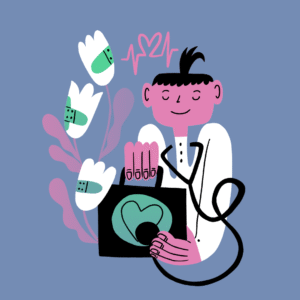
4.1 Orientation
Learning objectives for this chapter:
- You understand the basic gender-related inequalities in work & unpaid work and innovation.
- You know how the invisibility of care and unpaid work in the economy causes a gender-related distortion and inequalities in society.
Reflect on the questions below to orientate to the upcoming theme of care & work.
What does the word care mean to you?
- How is care present in your life?
- Do you offer care, are you perhaps dependent on care from others, do you benefit from (public) care services?
- What do you care about, and what do you care for?
4.2 Income and Wealth Equality
Income equality is something feminists have spent a long time working towards. It has not been achieved yet, as men still earn more than women on average. The pay gap
is partly caused by the employees in certain sectors being predominantly women or predominantly men, but this does not explain everything, and neither do differences in duties and responsibilities. The so-called unexplained pay gap is rooted in attitudes. Work performed by women is not valued the same as that performed by men. Another explanation is that women typically ask for lower pay than men, and on the other hand, men’s high expectations for their initial pay or pay rise are more likely to be received favourably, regardless of the manager’s gender.
Intersectional discrimination, i.e. discrimination based on multiple factors, also affects pay gaps. The more factors of disadvantage a person has, the larger the discrepancy between their income and that of the privileged group. For example, the disabled and other minorities often experience even greater income inequality than the pay gap between men and women.
Differences in income also affect pensions, and as a result, poverty in retirement is significantly more prevalent among women than men. In addition to the pay gap, the inequal sharing of care is also a contributing factor: women’s pension contributions accrue unevenly, because their careers are interrupted more often than men’s.
4.3 Katrine Marcal on women & economy
Why and how has unpaid work, done mostly by women, affected the history of economics and the understanding of economy today? In what ways are the venture money and investment and innovation gendered and how has femininity ended up being excluded from the history and understanding of progress and technology?
In this video, the best-selling author Katrine Marcal unwraps these questions and offers some answers and a lot more to think about.
4.4 Extending the concept of care – snippets from Dare to Care
GreenFeminism-ExtendingTheConceptOfCare
Care is part of everyone’s life, whether through supporting others, being supported, or depending on public services. Indeed, the only reason you and everyone around you is alive is because you received the care of others in moments when you needed it most.
- In your daily life, who takes on most of the care responsibilities, such as looking after children, elderly family members, or the home? Has anyone you know ever adjusted their life plans because they had to take care of someone?
- How would society change if the importance of care was more fully recognized and valued in society? How would it change the way we relate to each other, the economy, and nature?
5. Living as Oneself

5.1 Orientation
Learning Objectives: Living as Oneself
- You will know what entails bodily autonomy and the right for self-determination.
- You will understand the prerequisites of social structures for living in accordance with one’s own values.
- You can name some examples of measures to take in policymaking to make a shift towards a society that gives opportunities to a diversity of life paths.
5.2 Living as Oneself: Introduction
Living as oneself is connected to rights such as self-determination and bodily autonomy, as well as the individual’s overall chances of making life choices from their own standpoint and in line with their own values. Enabling people to live as themselves requires functioning legislation and a permissive culture, and in many cases, a functioning service system and social security system. Our legislation, system of social security, and many other structures define how we are able to live our lives.
In systems where the family is responsible for caring for those who need it, or where everyone makes care arrangements at their own cost, it is typical for women to stay home to care for both children and the elderly. This happens in many different societies and across income brackets. In the United States, for example, women are most likely to drop out of working life if their spouse belongs to either the top 10 percent or the bottom 10 percent of earners. Up to a third of women with degrees from top universities end up giving up their career and staying home to care for their children.
In the Nordic countries, an affordable and high-quality day-care system also enables parents of small children, most typically mothers, to go to work. On the other hand, the relatively generous level of social security allows people to focus on care when the children are small, for example, or when they want and need to do so. Social security also facilitates social mobility and generally enables resilience and survival in an uncertain world. In societies where social security is extremely ungenerous or non-existent, many people are forced to work even when it would benefit both the individual and the community in the long run if they were able to study. If the only way to put food on the table is through labour, it is understandable to choose work over education. Abortion legislation is one of the crucial issues related to self-determination. The answer to the political question on abortion rights should be obvious to everyone: making abortions freely available is rational legislation, plain and simple. Naturally, it is a good primary objective to implement other policies to ensure that as few people end up unwillingly pregnant as possible, but because it can occasionally still happen to a person with a uterus, it is necessary to make safe means of terminating the pregnancy available.
If the right to self-determination is not a convincing enough argument for access to abortion being common sense, it is also important to know that the number of abortions is the lowest in countries where they are broadly and freely available. Furthermore, legal abortions in countries where people with uteruses can freely obtain them are safe, while the stories of people living in countries with no legal access to abortion are grim and full of inequality. Free and wealthy adults are usually able to travel elsewhere to seek an abortion, but the options are extremely limited for young and poor people who find themselves unwillingly pregnant. This means that free access to abortion is also a matter of class.
5.2.1 Transgender, intersex, and other intersections
The transgender cause is a feminist cause. A good society enables everyone to live as themselves. There are people whose gender does not match the sex they were assigned at birth based on their genitalia. For people in this situation, it is crucial that they can legally correct their gender based on self-identification and that gender-affirming medical care is available.
Some children are born intersex, which means that it is not possible to discern which legal gender to assign to them based on their genitalia. In many cases, cosmetic surgery may be performed on these children to make their genitalia look either female or male. This was particularly common in the past. Such medically unnecessary interventions heavily violate the child’s right to self-determination, and they should not be performed on children. If the intersex person chooses to have surgery when they grow up, it should be available, but only at the person’s own request.
Matters related to age and disability are also crucial intersections. In other words, people who are at a disadvantage due to these factors are often in a difficult position for multiple reasons. It is part of the feminist cause to advocate for a better world for the elderly and disabled, while also making sure that these people’s own voices are heard. Likewise, feminism should strive to amplify the voices of all people belonging to various other minorities.
5.3 Anna Moring on diverse families
Family is a unit behind many structures of society, and this unit is undergoing a change. There is a big variety of different families – what are the diverse families like and how should the politics reflect this diversity?
6. Sustainable Future
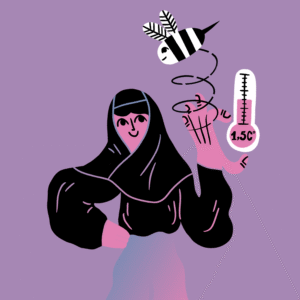
6.1 Orientation
Learning objectives for this theme:
- You will be able to argue why the climate crisis is a gender issue.
- You know what is the current state of gender equality in climate activism and policy.
- You can name some of the political mechanisms in place and possible steps towards climate justice in terms of gender.
Reflect on the questions below to orientate to the upcoming theme of sustainable future.
Imagine a world where humankind has stopped the exploitation of natural resources, where biodiversity loss has stopped and the climate is recovering.
- What would your daily life and life attitude look like compared to the present?
- What about the life of a woman in the global south?
6.2 A Sustainable future: Introduction
GreenFeminism-SustainableFuture
6.3 Gender and the climate crisis
Now we know how disproportionately the climate crisis affects different people. The most vulnerable people are those who have the least to do with the reasons behind the crisis. See the video to understand the role of gender in the disproportionate effects of the climate crisis and why we cannot afford to forget the gender factor when looking for solutions.
6.4 Sarah Parry on household sustainability and gender
In the context of the richest countries, the household is a site of change to achieve climate goals. Many actions to solve the crisis are directed at the household, including energy consumption, household chemicals, recycling, composting… And these actions target predominantly women. What is the problem with that and what could be the solutions in policymaking?
6.5 Feminist foreign policy as part of climate action
How can adaptation of feminist foreign policy can contribute in resolving the climate emergency?
There is not a feminist foreign policy in place in the European Union yet; however, some member states have adopted one (Sweden, France, Luxembourg and Spain), some are committed to developing one (Germany, Cyprus and Netherlands), and many have made gender equality a priority within their foreign policies.
A forerunner in this area has been Sweden, which announced the world’s first feminist foreign policy in 2014, with the contribution of Miljöpartiet de Gröna, the Swedish Greens, which was a coalition party in the Swedish government by the time. Sweden’s Feminist Foreign Policy is “a working method and a perspective that takes three Rs as its starting points and is based on a fourth R.”: Rights (promotion of all women’s and girls’ full enjoyment of human rights), Representation (women’s participation and influence in decision-making processes at all levels), Resources (the allocation of resources to promote gender equality) and Reality (standing for the solid empirical basis that the policy is based on).
“The purpose of the EU to define, adopt, and implement a Feminist Foreign Policy is to contribute to a peaceful world, in which everyone regardless of their gender, age, ability, race, sexuality, and class has the same rights, opportunities, and resources. In line with long-standing feminist traditions, peace is defined in a comprehensive manner that includes social justice and the elimination of structural violence at all levels. ‘Everyone’ explicitly includes all people living in non-EU countries. The differentiation between ‘us’ and ‘them’, between in- and outgroups, is a patriarchal logic that a Feminist Foreign Policy strives to overcome.”
The above suggestion for the purpose of EU’s Feminist Foreign Policy from the study written by Centre for Feminist Foreign Policy (CFFP). The quote elucidates well what the Feminist Foreign Policy means. This study on the current state of gender equality in the European Union’s foreign policy, and how to improve it (2020), was commissioned by the EU’s Greens/EFA.
The EU has developed a variety of initiatives, policies, and strategies within its external action that either incorporate a gender perspective or that actively aim at fostering gender equality; most prominently its Women, Peace and Security Agenda. However these are still problematic in some ways, of which the CFFP report raises the following:
- The absence of a comprehensive understanding of gender which accounts for the needs and perspective of gender non-confirming people and sexual minorities and recognises gender as a structural power relation.
- The tendency to see gender equality as a means to achieve other ends, such as more effective security or development, instead of pursuing it as a stand-alone goal.
- The failure to systematically account for gender inequality and the gendered norms as structural root causes of violence and conflict.
In October 2022, Sweden’s new right-wing government decided to scrap this pioneering policy. It’s a reminder that progress is never linear and we must continue pushing for feminist policies amid forces of backlash. Nevertheless, the Swedish example lives on in the many other countries and organisations that it has already inspired.
6.5.1 Connection to Climate
The European Commission’s focus on the climate emergency and the so-called “promotion of the European way of life”, and, more specifically, the core area of “fighting discrimination and promoting gender equality, particularly by safeguarding the rule of law and fundamental rights” can be seen as a fruitful starting point for a Feminist Foreign Policy, according to the study of CFFP. As climate change is, or in the very least should be, in the centre of foreign policies of all nations, adaption of a feminist foreign policy would directly feed into gender-mainstreaming in climate policy and gender-aware climate actions. In the suggestion of their report, CFFP raises climate as a priority for EU’s Feminist Foreign Policy: “Raise the EU’s ambition and capacities to mitigate the consequences of the climate crisis and to pursue climate justice as a guiding principle of the EU external action.”
The most recent announcer of feminist foreign policy, Mexico, shows a leading example on focusing on the link of gender discrimination and climate justice as a part of their foreign policy. In COP25, with the commitment and leadership from their government, Mexico promoted gender equality as a non-negotiable component of any agreement on climate change.
In spring 2021, the Greens/EFA released a strategy calling for a feminist foreign policy. The recommendations in the strategy include several on the interface of climate action:
- To increase women’s participation in climate change decision-making bodies at the national and international levels.
- To support the development, adoption and financing of the UNFCCC Gender Action Plan (GAP) complemented by a comprehensive and multi-year work programme that includes financing, priority action areas, timelines, key indicators of achievements, responsible actors, and monitoring and review mechanisms.
- To develop a comprehensive communication at EU level with the title “Gender equality and climate change – building resilience in mitigation and adaptation strategies”.
- To push for the compulsory appointment of national gender focal points for climate negotiations, implementation and monitoring.
- To appoint a permanent EU gender and climate change focal point, with sufficient budget resources, to implement and monitor gender-responsible climate action in the EU and globally.
- To ensure access of women’s organisations to international climate funds.
The effects of climate change are not experienced equally by everyone. Gender, location, and social position all shape how people are affected.
- Have you noticed whether climate-related decisions in your community consider the needs and perspectives of different groups, including women or other marginalized people?
- What might climate action look like if it also aimed to reduce inequality and support those most affected? Think about how environmental and social justice could come together in the places and choices that are familiar to you.
7. An Outlook on the Future of Feminism

7.1 Orientation
Learning objectives for this chapter:
- You will gain an overall picture of what the near future hold for feminist development.
- You will understand the most serious threat to gender equality in Europe; Anti-Gender Movements, their working mechanisms, networks and aims.
Reflect on the questions below to orientate to the upcoming theme of outlook to the future of feminism:
- What does a feminist future look like to you?
- Do you think it is achievable?
7.2 Obstacles and opportunities
One of the greatest threats to feminism is the anti-gender movement that has claimed more space in the discourse. This is not a feminist but a reactionary way of thinking, even if some people who subscribe to it may call themselves feminist. Feminism respects people’s right to self-identification. polarization, as both approaches have their uses and support each other. As mentioned earlier in the learning module, we need funny memes and comics just the same as activism and scientific research. They all work together by helping people make sense of the situation, providing tools for effecting change, and offering support for work that is rarely easy.
Above all, feminist action is about our way of viewing the world and our willingness to examine the structures, attitudes and assumptions to which we are accustomed. Very few things in human interaction are laws of nature and therefore unchanging or right by default. Feminist politics challenge us all to tolerate some uncertainty so that we can also view ourselves and our own actions in a critical light. It is not an unpleasant experience but a privilege not to assume that things will always remain the same as they are now. It is good to be able to understand that social interaction between humans changes with time and place. Each generation builds the society in their own image and develops feminist thinking further.
We, the authors, sincerely hope that some of this text is hopelessly out of date in ten years’ time. That feminist political thinking will have evolved and allowed us to overcome some of the present challenges and tackle new ones, the prevailing views will have changed, and more and more people will be able to have their voices heard louder and clearer.
7.3 Neil Datta on anti-gender movements
Anti-Gender Movements are a serious threat to equality development in Europe and worldwide, and results of the systematic influencing work behind the movements have already been witnessed. Watch the lecture by Neil Datta from the European Parliamentary Forum for Sexual and Reproductive Rights (EPF) to understand where we are at with the anti-gender movements, how they work and what the threats are.
7.4 Abortion rights in Europe
GreenFeminism-AbortionRightsinEurope
8. To wrap up…
This text has introduced you to the key intersections of feminism and the green movement, highlighting how both aim to create a more just, inclusive, and sustainable society. Of course, the two movements’ roots differ: Feminism emerged as a struggle for gender equality, while green politics primarily came about as a response to environmental degradation. But both share a commitment to challenging dominant power structures, amplifying marginalized voices, and transforming systems that prioritize profit and patriarchy over people and planet.
At the core of both movements is the understanding that the struggles for social justice and ecological justice are inseparable. The climate crisis does not affect everyone equally. It exacerbates existing inequalities, particularly for women and marginalized groups. Feminist analysis helps us see how care work, economic systems, bodily autonomy, and access to power are all embedded in broader environmental and societal structures. Likewise, green thinking widens the feminist lens to include the well-being of non-human life and future generations.
Importantly, green feminism is not just a theoretical framework. It is a lived practice that informs political structures, personal decisions, and collective action. From co-leadership models in Green parties to gender-responsive climate policies, green feminism shows us that an alternative future is not only imaginable but already in motion.
But this future is not guaranteed. Rising anti-gender movements and environmental backsliding remind us that gains can be undone. The work of green feminism, therefore, is ongoing. It challenges us to continuously reflect, adapt, and organize across differences and beyond borders.
How can green feminism help us define progress and prosperity not just for people, but for the planet as a whole?
- What does solidarity across social and environmental movements look like in practice, and how can we build it more intentionally?
- In what ways can you apply the principles of green feminism in your own life, community, or activism?
9. Additional Resources
Introduction to Green Feminism:
Introduction and history of feminism:
- We should all be feminists | Chimamanda Ngozi Adichie | TEDxEuston
- The Feminist Paradox | Thisari Randunu | TEDxYouth@TWSDubaiWomen
- Why Gender Equality Is Good for Everyone — Men Included | Michael Kimmel | TED Talks
- Women and Autism. Towards a Better Understanding | Sarai Pahla | TEDxMünster
Power:
- https://www.euronews.com/my-europe/2022/07/05/how-do-eu-member-state-parliaments-compare-on-gender-equality
- https://eige.europa.eu/news/quotas-can-turbocharge-progress-gender-balance-politics-and-business
- https://www.greeneuropeanjournal.eu/more-than-numbers-building-a-feminist-democracy/
- https://www.greeneuropeanjournal.eu/feminist-finland-from-representation-to-equality/
Money:
- https://www.greens-efa.eu/en/article/study/the-gender-budgeting-report-of-the-european-parliament
- https://you.wemove.eu/campaigns/halfofit-we-demand-half-of-the-corona-funds-for-women
- https://europeangreens.eu/news/green-recovery-feminist-recovery
- https://www.greeneuropeanjournal.eu/the-pandemic-is-gendered-and-so-is-recovery/
- https://www.greeneuropeanjournal.eu/counting-for-nothing-how-economics-excludes-women/
- https://www.greeneuropeanjournal.eu/fighting-the-privilege-hazard-a-feminist-data-intervention/
Work & Care:
- Katri Kiukas: Hoivan puolesta https://nuorivoima.fi/lue/essee/hoivan-puolesta (essay in Finnish)
- Dare to Care: https://gef.eu/publication/dare-to-care/
- https://www.greeneuropeanjournal.eu/fighting-the-patriarchy-to-save-the-planet/
- https://www.greeneuropeanjournal.eu/the-cost-of-care-rethinking-value-in-times-of-crisis/
Living as oneself:
- Katri Kiukas: Kohtu on kaunein sana – esseitä hoivasta, kumouksesta ja elämästä äitinä (collection of essays in Finnish)
- Nelli Ruotsalainen: Kumouksellinen äitiminen https://nuorivoima.fi/lue/essee/kumouksellinen-aitiminen (essay in Finnish)
- Nelli Ruotsalainen: Synnytä kuin feministi https://tulva.fi/lue/essee-synnyta-kuin-feministi/ (essay in Finnish)
- EAPN Finland Poverty Watch 2020
- https://www.greeneuropeanjournal.eu/we-no-longer-ask-to-be-treated-as-humans-we-demand-it/
- https://www.greeneuropeanjournal.eu/what-overturning-roe-v-wade-means-for-the-usa-and-beyond/
Sustainable future:
- Climate Feminism, audiobook by Linnea Engström https://gef.eu/publication/climate-feminism-audiobook/?_sft_related-focus=feminism
- Feminist Action for Climate Justice. Generation Equality -campaign by UN Women.
- https://forum.generationequality.org/sites/default/files/2021-10/Feminist%20Action%20for%20Climate%20Justice%20Action%20Coalition%20-%20Collective%20Commitments.pdf
- Implementation of gender-responsive climate action in the context of sustainable development – report of the expert group meeting https://unfccc.int/files/gender_and_climate_change/application/pdf/egmreport.pdf
- Green feminist foreign policy for the EU https://eu.boell.org/en/2021/09/13/green-feminist-foreign-policy-eu
- Greens/EFA strategy: Making the EU Foreign Policy a Feminist One https://www.greens-efa.eu/en/article/document/making-the-eu-foreign-policy-a-feminist-one
- Feminist Policies for Climate Justice. A report by Concord Sverige. https://concord.se/wp-content/uploads/2020/06/fem-rapport-2020-final.pdf
- A Green Feminist Foreign Policy for the EU https://www.greeneuropeanjournal.eu/a-green-feminist-foreign-policy-for-the-eu/
Information on the Authors
This text was created by the Green European Foundation in collaboration with
- Visio – the Finnish Green Educational Centre and Think Tank
- Naisasialiitto Unioni / The Feminist Association Unioni
- Eekku Aromaa, general secretary
- Fatim Diarra, president
And with the support of:
- Finnish Green Women’s Association
- Finnish Young Greens
- Fundacija Strefa Zieleni
- Green Economics Institute
- Green Thoughts Association Turkey
- Oikos

